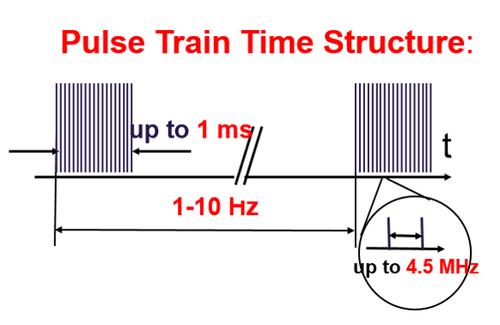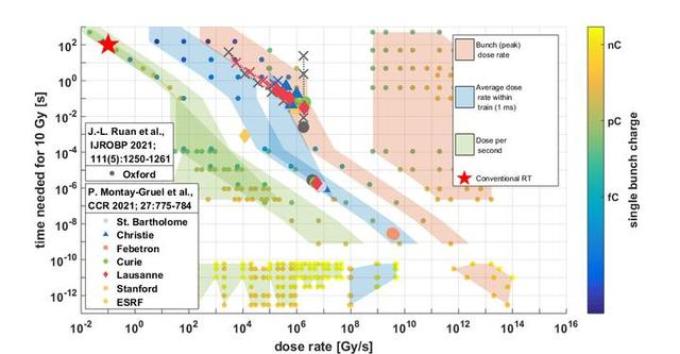The electron bunch time structure at PITZ: from adjustable bunch length (ps) to adjustable number of bunches in a bunch train (from us to ms) to adjustable number of bunch trains at 1-10 Hz (from seconds to minutes).
Beam time request
Photo Injector Test Facility at DESY, Zeuthen site
Beam time request
The PITZ facility usually runs for two continuous weeks with three shifts per day:
> 07:00 - 15:00
> 15:00 - 23:00
> 23:00 - 07:00
Generally, there is one running block in every calendar month. Between the running blocks, there are shutdown weeks for the tunnel work. A detailed run schedule planned for the whole calendar year can be obtained at request.
The properties of electron beam at PITZ
The PITZ accelerator consists of a normal-conducting L-band RF gun and cut-disk structure booster accelerator. The beam energy after the gun and the booster is up to 7 MeV and 22 MeV, respectively.
The electrons are emitted from a semiconductor photocathode (Cs2Te) by illuminating it with a UV laser pulse (photoelectric effects), therefore the bunch time structure is defined completely by that of the laser, which is shown as below.

The electron beam properties from the PITZ accelerator are given in the table:
|
Property |
Value |
|---|---|
|
Energy |
< 22 MeV |
|
Charge |
pC - 5 nC |
|
FWHM |
0.1 - 30 ps |
|
RMS size |
0.02 - a few mm |
Possible dose parameter range at PITZ
|
Mode |
# of e-bunches |
Duration |
Dose (Gy) |
Dose rate (Gy/s) |
|---|---|---|---|---|
|
Single bunch |
1 |
0.1-30 ps |
0.02 - 10^3 |
10^9 - 10^14 |
|
Multi-bunches in single train |
2-4500 |
0.22 us - 1 ms |
0.02 - 10^6 |
10^4 - 10^9 |
|
Multi-trains |
>1 |
> 0.1 s |
> 0.02 |
> 0.02 |
The available PITZ parameter space is shown and compared to others in the below figure.

The time needed for 10 Gy and corresponding dose rates calculated within the duration of the electron bunch, the length of the bunch train or per second, respectively. Solid markders show the dose rates used in other laboratories where the FLASH effects have been confirmed and crosses where the FLASH effects were not observed.
Currently, PITZ has a startup beamilne for doing in-vitro experiments and studying dosimetry. Due to the dispersion effects and the lack of focusing magnets in the dispersive arm, the dose parameters are limited. The available dose parameters from this beamline are given in the table below.
|
Dose rate (Gy/s) |
Bunch charge (nC) |
Separation of bunches |
Irradiation time |
|
|---|---|---|---|---|
|
CONV |
0.05 |
0.01 - 0.03* |
0.1 s |
a few seconds - minutes |
|
UHDR |
10^5 - 10 ^6 |
0.3 - 1* |
1 us |
a few us to 1 ms |
|
Background |
~ 10^-3 |
* Bunch charge and beam size are varied, depending on the different sizes of samples and required homogeneity of dose distributions (via scattering plates).
Ongoing upgrade of FLASHlab@PITZ

The upgraded beamline for FLASHlab@PITZ consists of an achromatic dogleg to shift the electron beam to a separated section, quadruples to focus the electron beam and a 2D sweeper to scan the beam for pencil beam scanning studies using electrons. A robot copied from CLEAR will be installed after the exit window for sample alignment. The new beamline will provide the full parameter range discussed above.
Download the beam time request form
For more information, please contact:
Matthias Gross (matthias.gross@desy.de),
Xiangkun Li (xiangkun.li@desy.de), or
Frank Stephan (frank.stephan@desy.de).
